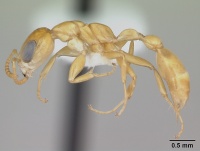Pseudomyrmex holmgreni
| Pseudomyrmex holmgreni | |
|---|---|

| |
| Scientific classification | |
| Kingdom: | Animalia |
| Phylum: | Arthropoda |
| Class: | Insecta |
| Order: | Hymenoptera |
| Family: | Formicidae |
| Subfamily: | Pseudomyrmecinae |
| Genus: | Pseudomyrmex |
| Species: | P. holmgreni |
| Binomial name | |
| Pseudomyrmex holmgreni (Wheeler, W.M., 1925) | |
Identification
Ward (1989) - Contrary to statements in the original description, this widespread South American species is not closely related to Pseudomyrmex filiformis. Rather, it is a member of the P. pallidus group, bearing some resemblance to Pseudomyrmex euryblemma (q.v.) but differing in the following worker characters: metanotal groove wider and more deeply incised; basal face of propodeum subequal in length to declivitous face (longer than the declivitous face in P. euryblemma); and head tending to be more elongate, with the sides rounding more gradually into the occipital margin. The workers and queens of P. holmgreni vary considerably in color, from concolorous orange to dark brown, including intermediate forms with variable degrees of infuscation of the body.
Distribution
Latitudinal Distribution Pattern
Latitudinal Range: 10.701° to -34.583333°.
| North Temperate |
North Subtropical |
Tropical | South Subtropical |
South Temperate |
- Source: AntMaps
Distribution based on Regional Taxon Lists
Neotropical Region: Argentina, Paraguay, Peru (type locality), Trinidad and Tobago.
Distribution based on AntMaps
Distribution based on AntWeb specimens
Check data from AntWeb
Countries Occupied
| Number of countries occupied by this species based on AntWiki Regional Taxon Lists. In general, fewer countries occupied indicates a narrower range, while more countries indicates a more widespread species. |

|
Estimated Abundance
| Relative abundance based on number of AntMaps records per species (this species within the purple bar). Fewer records (to the left) indicates a less abundant/encountered species while more records (to the right) indicates more abundant/encountered species. |

|
Biology
This species is a host for the ant Pseudomyrmex filiformis (a temporary parasite) (Ward, 1996).
Castes
Worker
Images from AntWeb
   
| |
| Worker. Specimen code casent0173757. Photographer April Nobile, uploaded by California Academy of Sciences. | Owned by ALWC, Alex L. Wild Collection. |
   
| |
| Worker. Specimen code casent0178618. Photographer April Nobile, uploaded by California Academy of Sciences. | Owned by MIZA, Maracay, Venezuela. |
Male
Images from AntWeb
     
| |
| Male (alate). Specimen code casent0173758. Photographer April Nobile, uploaded by California Academy of Sciences. | Owned by ALWC, Alex L. Wild Collection. |
Nomenclature
The following information is derived from Barry Bolton's Online Catalogue of the Ants of the World.
- holmgreni. Pseudomyrma holmgreni Wheeler, W.M. 1925a: 11 (w.) PERU. Combination in Pseudomyrmex: Kempf, 1972a: 220. See also: Ward, 1989: 440.
Type Material
- Lectotype (designated by Ward (1989)), worker, Chaquimayo, Peru, N. Holmgren, Naturhistoriska Riksmuseet.
- Paralectotype (designated by Ward (1989)), worker, Chaquimayo, Peru, N. Holmgren, Naturhistoriska Riksmuseet.
Description
Karyotype
- See additional details at the Ant Chromosome Database.
 Explore: Show all Karyotype data or Search these data. See also a list of all data tables or learn how data is managed.
Explore: Show all Karyotype data or Search these data. See also a list of all data tables or learn how data is managed.
- 2n = 50, karyotype = 6M+44A or 2M+48A (Brazil) (Sposito et al., 2006).
References
- Kempf, W. W. 1972b. Catálogo abreviado das formigas da regia~o Neotropical. Stud. Entomol. 15: 3-344 (page 220, Combination in Pseudomyrmex)
- Tibcherani, M., Aranda, R., Mello, R.L. 2020. Time to go home: The temporal threshold in the regeneration of the ant community in the Brazilian savanna. Applied Soil Ecology 150, 103451 (doi:10.1016/j.apsoil.2019.103451).
- Ward, P. S. 1989a. Systematic studies on pseudomyrmecine ants: revision of the Pseudomyrmex oculatus and P. subtilissimus species groups, with taxonomic comments on other species. Quaest. Entomol. 25: 393-468 (page 440, see also)
- Wheeler, W. M. 1925a. Neotropical ants in the collections of the Royal Museum of Stockholm. Ark. Zool. 17A(8 8: 1-55 (page 11, worker described)
References based on Global Ant Biodiversity Informatics
- Bezdeckova K., P. Bedecka, and I. Machar. 2015. A checklist of the ants (Hymenoptera: Formicidae) of Peru. Zootaxa 4020 (1): 101–133.
- Boudinot B. E. 2015. Contributions to the knowledge of Formicidae (Hymenoptera, Aculeata): a new diagnosis of the family, the first global male-based key to subfamilies, and a treatment of early branching lineages. European Journal of Taxonomy 120: 1-62.
- Coelho M. S., G. W. Fernandes, J. C. Santos, and J. H. C. Delabie. 2009. Ants (Hymenoptera: Formicidae) as bioindicators of land restoration in a Brazilian Atlantic forest fragment. Sociobiology 54(1): 51-63.
- Enzmann E. V. 1944. Systematic notes on the genus Pseudomyrma. Psyche (Camb.) 51: 59-103.
- Fernández, F. and S. Sendoya. 2004. Lista de las hormigas neotropicales. Biota Colombiana Volume 5, Number 1.
- Kempf, W.W. 1972. Catalago abreviado das formigas da regiao Neotropical (Hym. Formicidae) Studia Entomologica 15(1-4).
- Silvestre R., C. R. F. Brandão, and R. R. Silva da 2003. Grupos funcionales de hormigas: el caso de los gremios del cerrado. Pp. 113-148 in: Fernández, F. (ed.) 2003. Introducción a las hormigas de la región Neotropical. Bogotá: Instituto de Investigación de Recursos Biológicos Alexander von Humboldt, xxvi + 424 pp.
- Vittar, F. 2008. Hormigas (Hymenoptera: Formicidae) de la Mesopotamia Argentina. INSUGEO Miscelania 17(2):447-466
- Vittar, F., and F. Cuezzo. "Hormigas (Hymenoptera: Formicidae) de la provincia de Santa Fe, Argentina." Revista de la Sociedad Entomológica Argentina (versión On-line ISSN 1851-7471) 67, no. 1-2 (2008).
- Ward P. S. 1990. The Ant Subfamily Pseudomyrmecinae (Hymenoptera: Formicidae): Generic Revision and Relationship to Other Formicids. Systematic Entomology 15: 449-489
- Ward P. S. 1992. Ants of the genus Pseudomyrmex (Hymenoptera: Formicidae) from Dominican amber, with a synopsis of the extant Antillean species. Psyche (Cambridge) 99: 55-85
- da Silva, R.R., C.R.F. Brandao, and R. Silvestre. 2004. Similarity Between Cerrado Localities in Central and Southeastern Brazil Based on the Dry Season Bait Visitors Ant Fauna. Studies on Neotropical Fauna and Environment 39(3):191-199.

